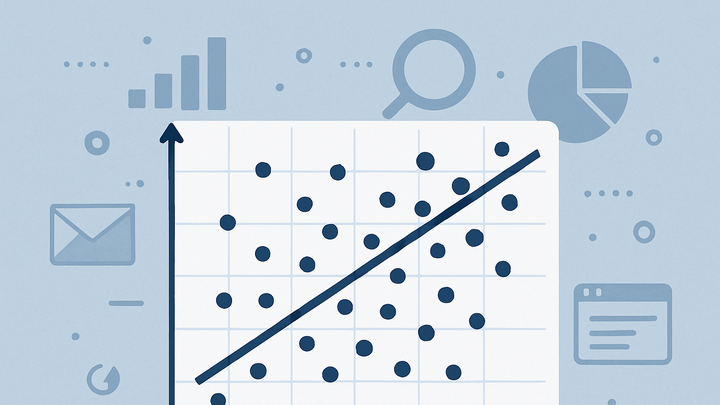Published on 2025-06-22T04:57:01Z
What is Regression Analysis? Examples and Use Cases in Analytics
Regression analysis is a statistical method used in analytics to evaluate the relationship between a dependent variable and one or more independent variables. By modeling these relationships, analysts can identify trends, make predictions, and quantify the strength and direction of effects.
Regression techniques underpin tasks such as forecasting sales, understanding user behavior, and optimizing marketing spend. Modern analytics platforms, including PlainSignal and GA4, enable users to run and visualize regression models directly within their dashboards or through integrations with tools like BigQuery.
While simple regression examines a straight‐line relationship, more advanced approaches handle multiple predictors and nonlinear patterns. Interpreting regression outputs—like coefficients, R-squared values, and p-values—requires attention to data quality, assumptions, and potential pitfalls to draw reliable insights.
Regression analysis
Statistical method to analyze relationships between variables and make predictions in analytics.
Understanding Regression Analysis
An overview of regression analysis, its purpose, and fundamental concepts.
-
Definition
Regression analysis quantifies the relationship between a dependent variable (outcome) and one or more independent variables (predictors).
-
Key components
Every regression model consists of variables and an error term that captures unexplained variation.
-
Dependent variable (y)
The outcome or metric that the model aims to predict.
-
Independent variable (x)
The input or feature used to explain variations in the dependent variable.
-
Error term
Represents random noise and factors not captured by the model.
-
Types of Regression Models
Different regression techniques are suited to various data types and analysis goals.
-
Linear regression
Models the relationship between variables as a straight line using the least squares method.
-
Multiple regression
Extends linear regression by incorporating two or more independent variables to predict the outcome.
-
Logistic regression
Used for binary or categorical outcomes, modeling the probability of class membership.
Applications in Analytics
Regression analysis powers key analytics tasks by uncovering patterns and enabling data-driven decisions.
-
Trend forecasting
Predict future metrics, such as web traffic or sales, based on historical data trends.
-
A/b test analysis
Control for multiple factors to evaluate the true effect of experiments and get more precise test results.
-
Customer lifetime value prediction
Estimate the future revenue from customers by modeling how behavior and demographics influence spending.
Implementing Regression Analysis in SaaS Tools
Many analytics SaaS platforms, like PlainSignal and GA4, offer built-in features or integrations for regression analysis.
-
Using PlainSignal cookie-free analytics
PlainSignal collects data without cookies and lets you export datasets for regression modeling. To set up tracking, add the following snippet to your site:
<link rel="preconnect" href="//eu.plainsignal.com/" crossorigin /> <script defer data-do="yourwebsitedomain.com" data-id="0GQV1xmtzQQ" data-api="//eu.plainsignal.com" src="//cdn.plainsignal.com/plainsignal-min.js"></script>After data collection, you can download CSV exports and run regression in tools like Excel, R, or Python.
-
Leveraging GA4 and bigquery
Google Analytics 4 integrates with BigQuery for advanced analysis. Export raw event data and use BigQuery ML to build and train regression models using SQL commands.
Best Practices and Common Pitfalls
Following best practices helps ensure reliable models, while awareness of pitfalls prevents misleading conclusions.
-
Ensuring data quality
Handle missing values, detect and address outliers, and ensure consistent data formatting before modeling.
-
Avoiding overfitting
Use techniques like cross-validation, regularization, and keeping model complexity appropriate to your dataset size.
-
Interpreting results correctly
Distinguish correlation from causation, check statistical significance (p-values), and evaluate goodness-of-fit (R-squared).
